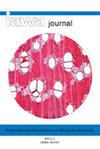热带木材颜色的多样性及其与木材密度和解剖特征的关系
IF 3.5
3区 农林科学
Q2 FORESTRY
引用次数: 0
摘要
利用 CIELab 颜色参数描述了印度(果阿)、莫桑比克和东帝汶 98 种热带树种的木材颜色变异性,并将其与木材密度和解剖特征联系起来。木材颜色多为浅黄色,木材亮度范围为 24.0-84.4,红度范围为 2.6-20.4,黄度范围为 1.8-36.6,色度范围为 2.1-35.9,色调角度范围为 27.5-81.6。在色彩参数中,L*和 b* 之间的正相关性最为显著,其次是 L* 和 a* 之间的负相关,而 a* 和 b* 之间的正相关性并不显著。L* 与 h 和 C* 之间的正相关性也非常显著。CIELab 颜色参数与木材密度有明显的相关性,其中 L* 的负相关性最强,其次是 b* 的负相关性。木材颜色与所研究的定量解剖特征的相关性不强,L*与纤维壁厚度/纤维宽度比之间以及b*与纤维长度之间只有微弱的负相关。木材密度几乎与所有解剖特征都相关,与纤维壁厚度/纤维宽度比和纤维宽度的相关性最强。与浅色木材相比,深色热带木材的木材密度高、纤维壁比例高、血管频率高、血管窄。总体而言,热带树种木材颜色的多样性有助于通过纳入鲜为人知的树种来扩大国际木材市场,从而促进当地的发展和濒危热带树种的可持续发展。本文章由计算机程序翻译,如有差异,请以英文原文为准。
Diversity of wood colour in tropical timber species and its relationship with wood density and anatomical features
The wood colour variability of 98 tropical species from India (Goa), Mozambique and East Timor was described using CIELab colour parameters and related to wood density and anatomical features. Wood colours were mostly light and yellowish, ranging from 24.0–84.4 for wood lightness, 2.6–20.4 for redness, 1.8–36.6 for yellowness, 2.1–35.9 for chromaticity and 27.5–81.6 for hue angle. Among the colour parameters, the positive correlation between L* and b* was the most significant, followed by a negative correlation between L* and a*, while the positive correlation between a* and b* was non-significant. Positive correlations between L* and both h and C* were also highly significant. CIELab colour parameters were significantly correlated to wood density, the stronger negative correlation was found with L*, followed by the negative correlation with b*. Wood colour was not strongly correlated with the quantitative anatomical features studied showing only weak negative correlations between L* and the fibre wall thickness/fibre width ratio and between b* and fibre length. Wood density was correlated to almost all anatomical features showing the strongest correlations with fibre wall thickness/fibre width ratio and fibre width. The darker-coloured tropical woods showed high wood density, high fibre wall proportion, high vessel frequency and narrow vessels compared to the lighter coloured woods. Overall, wood colour diversity of tropical species could contribute to increase the international timber market by including lesser-known species, which would enhance local development and sustainability of endangered tropical species.
求助全文
通过发布文献求助,成功后即可免费获取论文全文。
去求助
来源期刊

IAWA Journal
农林科学-林学
CiteScore
3.40
自引率
15.80%
发文量
26
审稿时长
>36 weeks
期刊介绍:
The IAWA Journal is the only international periodical fully devoted to structure, function, identification and utilisation of wood and bark in trees, shrubs, lianas, palms, bamboo and herbs. Many papers are of a multidisciplinary nature, linking
 求助内容:
求助内容: 应助结果提醒方式:
应助结果提醒方式:


